Settler land grabs; forced evictions in Sheikh Jarrah; incessant air raids in Gaza; increasing militarization and blockades of Hebron; state-sanctioned violence on property, agriculture, and civilians throughout the West Bank: the daily realities of Israeli apartheid have become more visible through social media over the last several years. The instantaneity and ubiquity of cell phone footage has also made visible the attempts to silence information about Palestinian rights violations, even as algorithms and social media shadow bans try to thwart their spread. Amid this proliferation of media, the Israeli courthouse remains veiled as a constructed space of inequality that transcends the spatial logics and dynamics of these familiar, publicized scenes of apartheid. While the Israeli judicial system has been laid bare—most notably through the work of Noura Erakat1—in terms of its history, legal structures, and humanitarian implications, the courthouse as a spatial system remains a fractured, illegible site where publicity is constantly regulated. The courthouse bears its own complex testimony in Rachel Leah Jones and Philippe Bellaïche’s 2019 documentary, Advocate, which follows the Israeli lawyer Lea Tsemel in and out of the Jerusalem district court as she defends two Palestinians in their respective criminal cases. As viewers quickly see, to document and film inside this legal space is to constantly negotiate how much publicity and accessibility Advocate can capture. What would it mean to understand how the courthouse, in its entirety, operates as part of this legal system? And what pressure might this transparency exert on Israel?
In an apartheid state where Palestinians are mostly noncitizens but subject to Israel’s legal framework, Israeli courthouses are a peculiar entity. Supplemented, if not overpowered, by extralegal violence that seeks to discipline Palestinians on a daily basis, the courthouse becomes a site where order is purported to be civil, non-militaristic, and regulated. It is also a space where visual and physical access is always elusive. While contemporary TV shows like Our Boys (Cedar 2019) depicted the Israeli courtroom through a fictionalized and highly dramatized staging of a historic Israeli criminal case, the documentary Advocate never sets foot into an actual courtroom. The camera is confined to hallways, stairwells, elevator banks, lobbies, and sidewalks, orbiting but never accessing the courtrooms. While the camera is beholden to the broader limitations of capturing and documenting the occupation, the film exposes the many overlooked and understudied situations that unfold in the system’s interstices. Though the verdicts are determined behind the courtroom door, Advocate reveals that there are equally critical events that take place before and after every hearing in these banal spaces.
Through Advocate’s capturing of various rooms of the courthouse, the camera reveals an interstitial space that is not singular, consistent, or limited to the courtroom itself. In this space realities are negotiated, new encounters are produced, and civil foibles unfold. An overladen term in architecture discourse, the interstice becomes integral here to the ways in which law is subjective and erratic. These interstitial spaces—hallways, elevator banks, lobbies, turnstiles, gates, and sidewalks—each carry their own set of conditions that determine how bodies, media, and narratives are regulated.
At stake here is a rethinking of the courthouse as an entangled architectural, mediatic, and carceral system, not only as a programmatic type. It is important to highlight the current condition of Palestinian media in terms of its production and regulation. Interdisciplinary scholars—many of whom are grounded in architecture studies, such as Cornelia Vissman2 and Eyal Weizman3—have analyzed the courtroom as a space where outside evidentiary objects are negotiated, presented, and contested, acting as a forum that is “dynamic and contingent, temporary, diffused, and networked by new technology and media.”4 The courtroom operates through both architecture and media: podiums, doors, private and public corridors; photographers, reporters, interviews, documents. The legal scholar Piyel Haldar writes about the court as a site of negotiation between the heard and the excluded, the ritual and the quotidian, truth and falsity, logic and emotion. Through an architectural reading specific to the Israeli Supreme Court, Haldar identifies the many entrances and exits layered on-site, thresholds that strengthen the principle of interiority and provide a visual representation of the outside.5 As the Israeli state fashions itself to uphold law, order, safety, and security throughout society, the courthouse manifests its purported values: it becomes the state’s physical testament to that which it abstractly proclaims. While Haldar begins to think critically about this relationship between the internal judicial system and the physical outside, his analysis warrants further investigation into the ways that bodies, events, and media navigate these spatial conditions. Advocate testifies to this dimension through lived experience. In their book Mengele’s Skull: The Advent of Forensic Aesthetics, Eyal Weizman and human rights scholar Thomas Keenan document how the images of forensic evidence operate during a trial.6 The medium of documentary filmmaking, though, goes beyond the evidentiary. It is tasked with both capturing evidence in situ and in turn producing its own argument through cinematic techniques. As distinct from social media or the material documents and evidentiary photos Weizman and Keenan handle, this rendered evidence deserves attention and critical study alongside the more visible and public images of Palestine.
While the courtroom is certainly a site that filters, alters, and reconstructs external events, the interstitial spaces that serve the courtroom might better illuminate the carceral system at play. In these in-betweens, different spectacles are staged, identities and narratives are reconstructed, informal legal guidance is sought, and above all, Israeli inequalities and tensions throughout occupied Palestine are mirrored and intensified. Advocate further presents the court as an architecture that frames and produces news media spectacles. 7
The documentary follows Israeli public defender Lea Tsemel throughout her career from the aftermath of the Six-Day War of 1967 through the present day.8 Partially composed of archival footage, the majority of the film tracks Tsemel's actions at her office and at the Jerusalem District Court as she takes on two high-profile criminal cases: that of a thirteen-year-old boy, Ahmad Manasra, charged with murder for brandishing an ornamental knife at two Israeli men in Jerusalem; and of Israa Jaabis, a thirty-one-year-old woman accused of attempting a suicide bombing after a technical fault resulted in her car exploding.9 As public media circulated sensationalized stories about Ahmad and Israa, Advocate gave viewers a rare, necessary depiction of what happened in this opaque middle, in the courthouse itself. In the film, seemingly banal spaces of circulation become auxiliary sites of legal process as lawyers, defendants, families, and reporters traverse and pause in hallways and lobbies. To represent the trial of Ahmad, the film first shows a newsreel of his notable and highly publicized 2015 case. Ahmad, from the Palestinian village of Beit Hanina in East Jerusalem, and his fifteen-year-old cousin Hassan went to the illegal Pisgat Ze’ev settlement,10 where they stabbed two Israelis, one of them a security guard. The boys, Tsemel states, had no intention of killing, but rather intended to “cause pain and frighten.” Hassan was shot and killed by settlers on the street after attempting to flee, while Ahmad was run over by settlers and seriously injured.11 The viewer watches Tsemel process this newsreel, which features footage of settlers screaming and cursing at the bleeding Ahmad, who is gasping and reaching his hand out for help. Here, before entering the courtroom, the film frames techniques that Israeli media use to depict Palestinians as criminal characters. Ahmad and Israa both become more than individuals: they are spectacles constructed between the goalposts of the built legal environment.
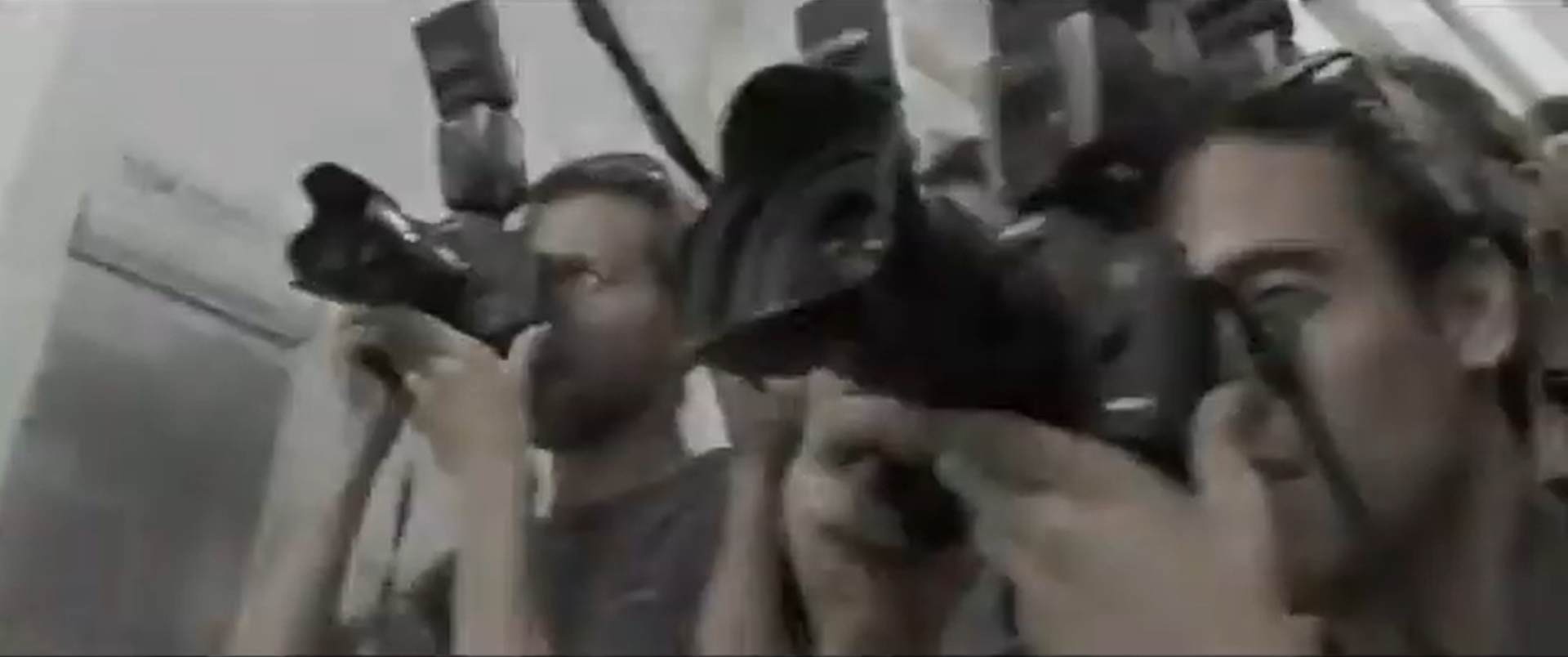

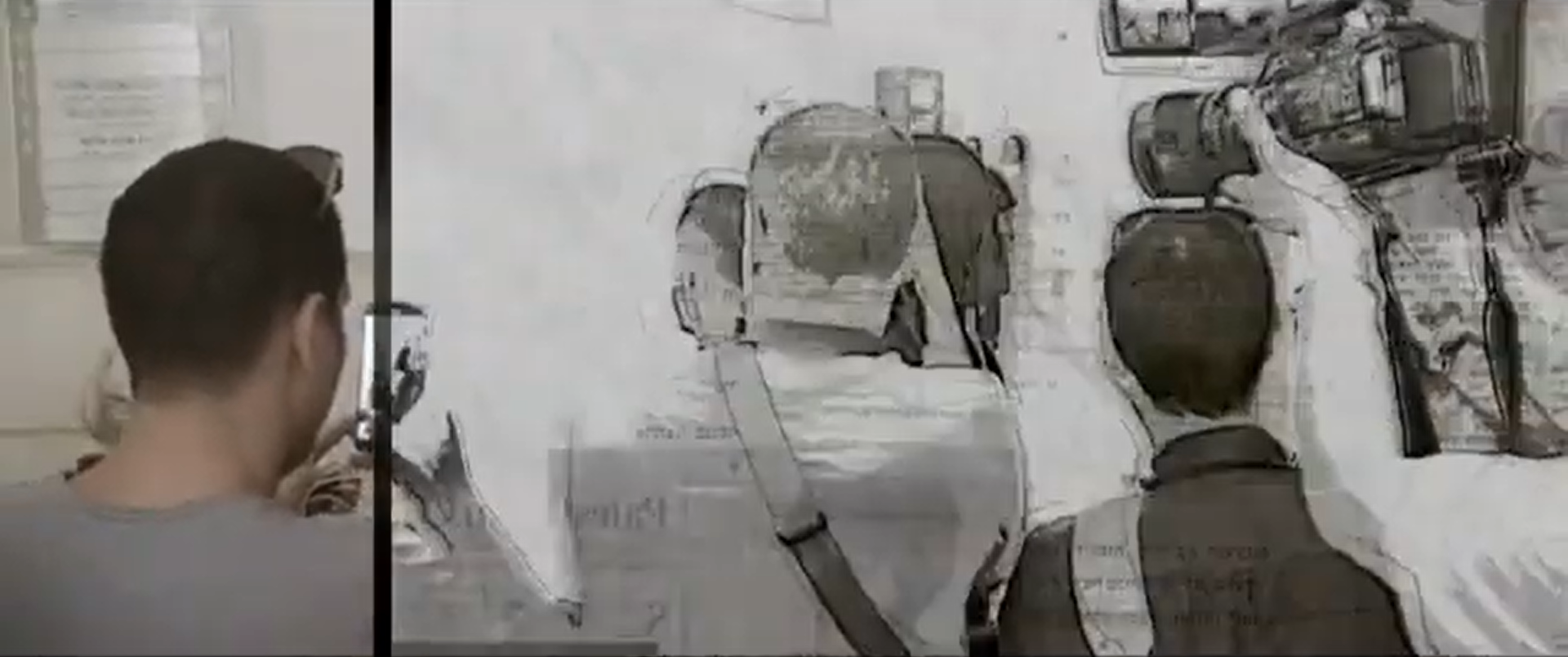
Waiting impatiently by the elevator bank before the trial and by the courtroom doors after, a hive of media photograph Ahmad and Israa. As a general spatial condition that fragments circulation, elevators chop up vertical continuity between spaces, spitting out its occupants abruptly onto a new floor. This spatial condition, nearly ubiquitous to large public buildings, becomes ripe for photographers to exploit as a site of courtroom spectacle. The elevator doors open, leaving each defendant stunned, with little time to cover their faces. The corridors connecting the elevator to the courtroom stage another long photographable moment. After the court has adjourned, Ahmad and Israa must each walk back to the elevator. In this egress they process and discuss the news they just received inside the chamber, which gives the media ample time to watch and photograph them.
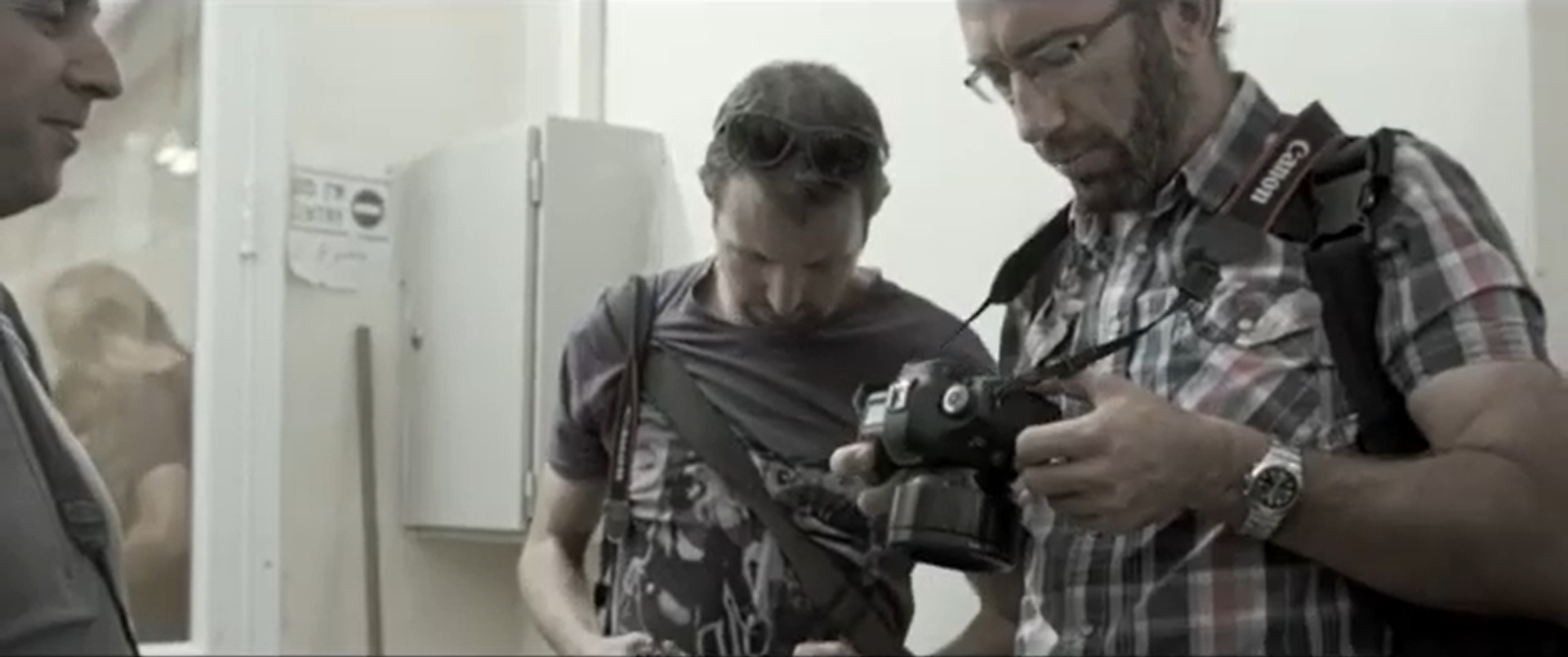
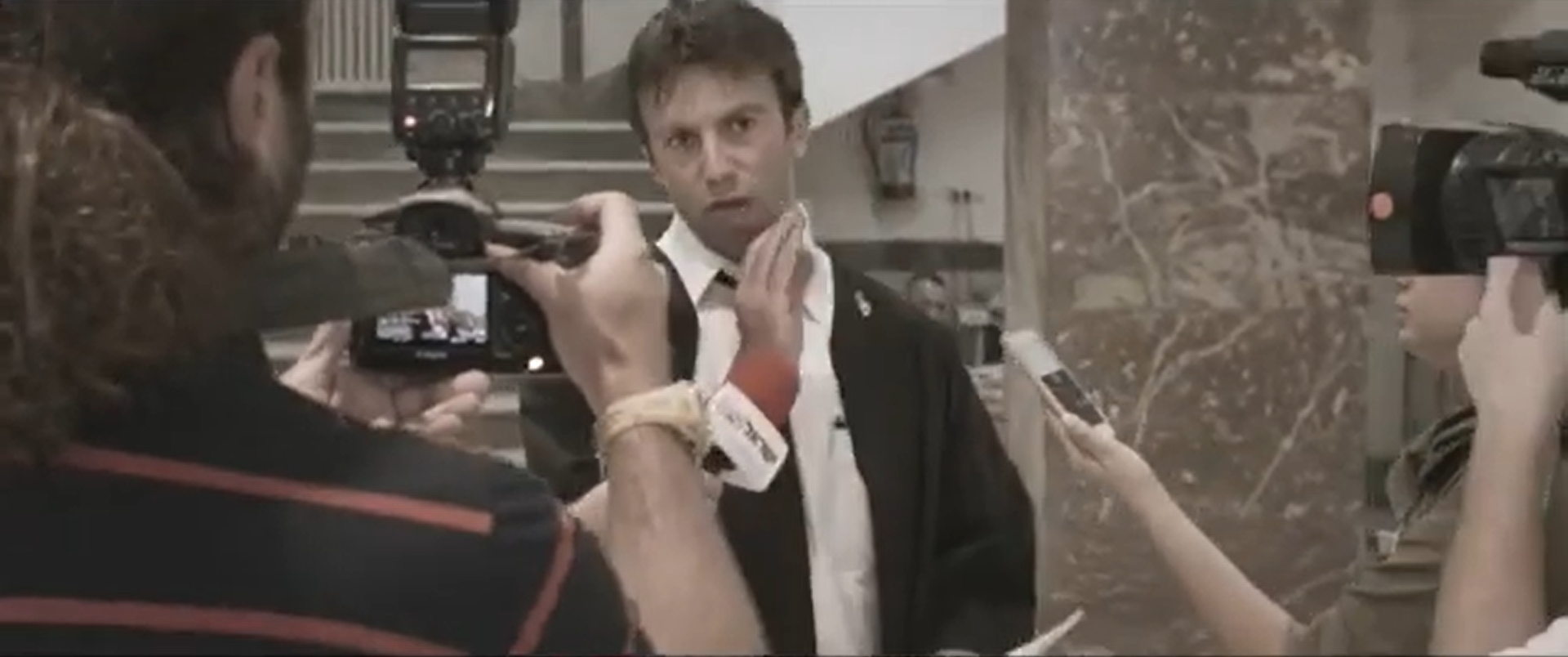
What enables Israeli court architecture to create these spectacles? For Ahmad and Israa, their spectacular fates differ.12 While the court is in session, the photographers review their images of Ahmad. The camera zooms in on their screens showing photos of what looks like Ahmad crying or, according to the photographer, smiling. These images are slippery and open to interpretation. After the court session, a new space emerges: the lobby. As photographers reconstruct Ahmad’s media character from photos, it is now the prosecutor who reports on Ahmad and the trial verbally. In the lobby, the photographers do not have to hunt for material, but instead have it delivered via interview. In front of cameras and microphones, the prosecutor labels Ahmad a “terrorist” for the reporters to circulate in the world outside. Perhaps because it is most accessible to the public, the lobby lends itself to planned theatrical situations. It becomes a crucial mediator of realities, narratives, and testimonies, where the media and prosecutors are able to construct and project their own version of the truth, one that affirms Israeli state power and demonizes Palestinian defendants. It is no coincidence that this space is revealed to the viewer after having seen newsreels, meetings with Ahmad’s family in Tsemel’s office, and makeshift scenes in the courtroom corridors. As a documentary film, Advocate gives us the distance needed to see these larger architectural, media, and carceral systems working together.
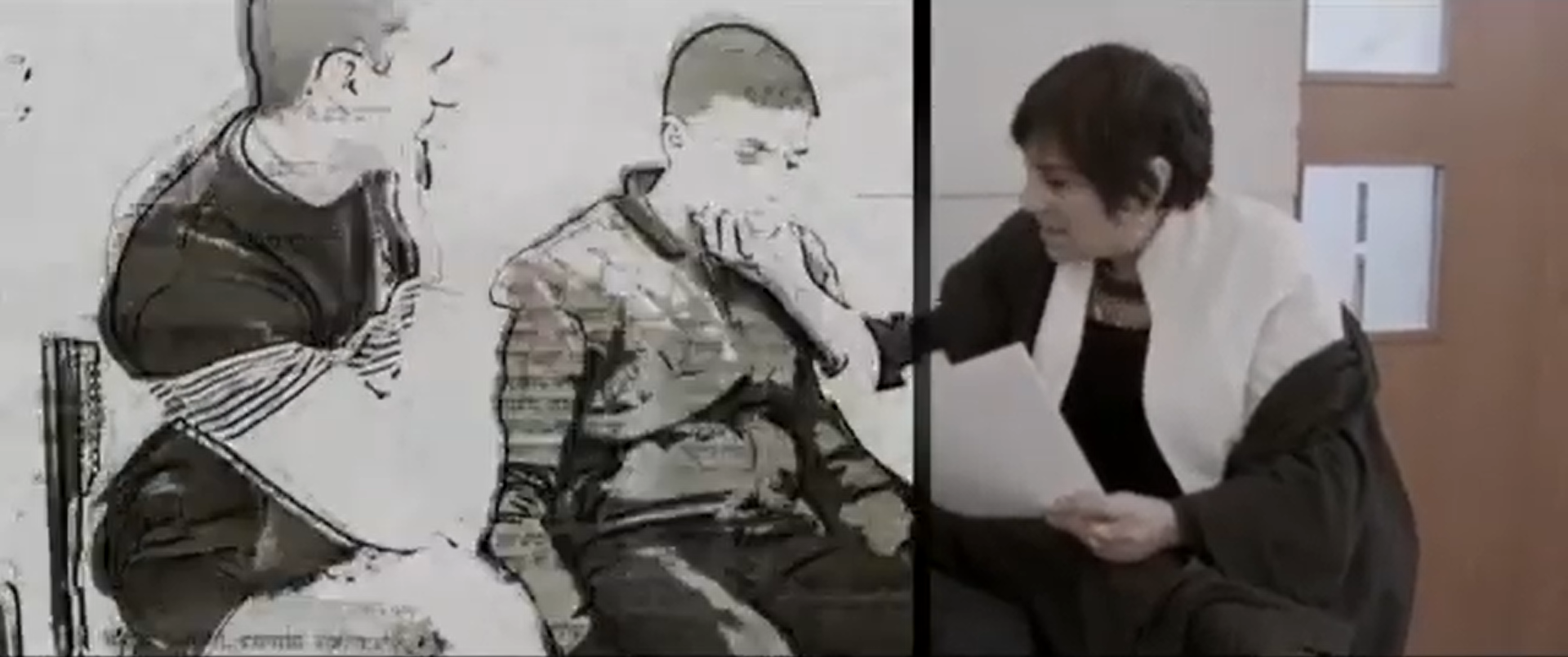
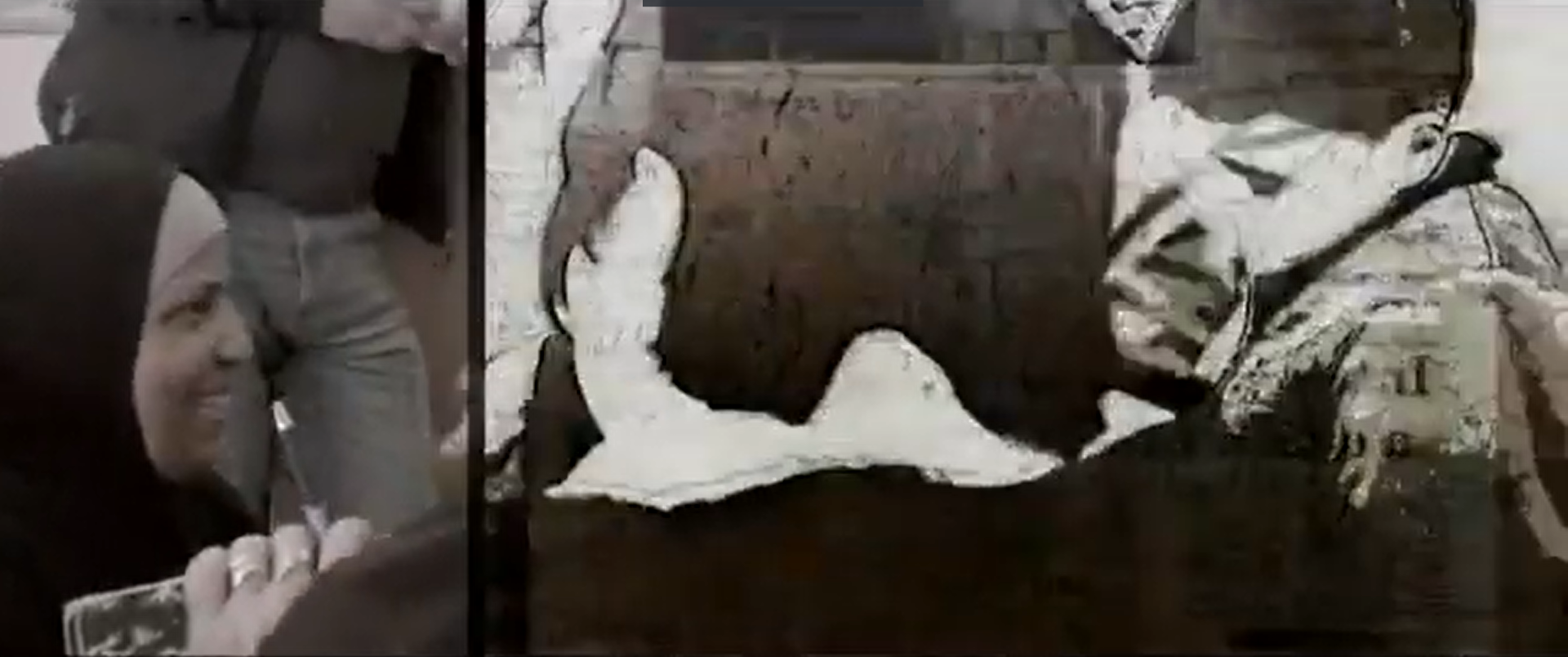
The hallway offers moments of respite in Advocate: sometimes, this linear corridor allows informal legal counsel to take place. While Tsemel can meet with Ahmad’s parents at her office to review plea negotiations, her time with Ahmad himself is confined to courtroom session breaks. Here in the hallway adjacent to the courtroom, Tsemel often finds a bench where she can speak with Ahmad alongside his father, giving him guidance on how to answer questions and, crucially, telling him what his testimony does for their case. However, the documentary shows how this respite space is makeshift and exposed. During Tsemel’s counseling, two Palestinian women interrupt her to start kissing Ahmad, praising him as a martyr and affirming to him that “all Palestinian mothers are mothers to [him].”13 Although this interruption contains support and sympathy, we see Tsemel get impatient; she is clearly frustrated with how little time she has with Ahmad, the lack of privacy, and the enormity of the task of getting a child to concentrate amid the chaos. Tsemel’s dependency on the hallway for private counsel demonstrates the degraded spatial conditions available to Palestinians within the Israeli legal system.
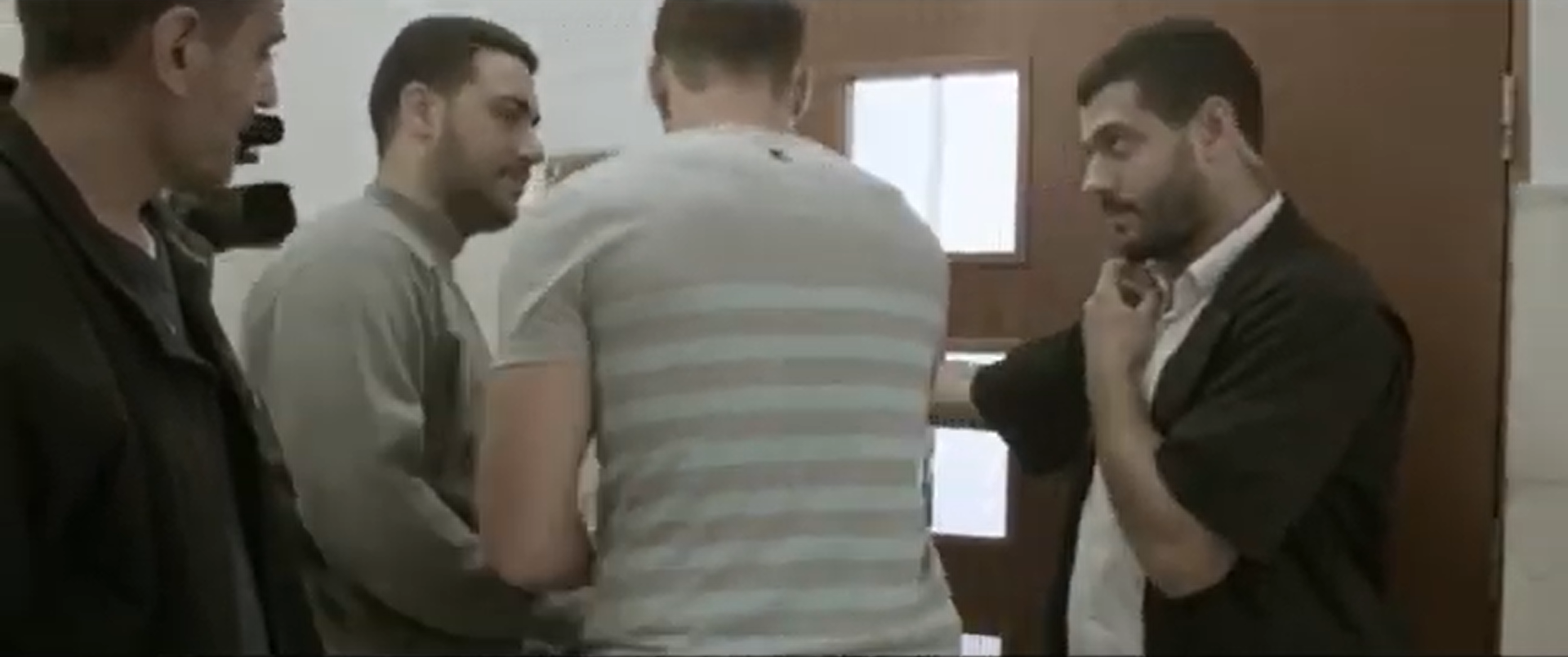
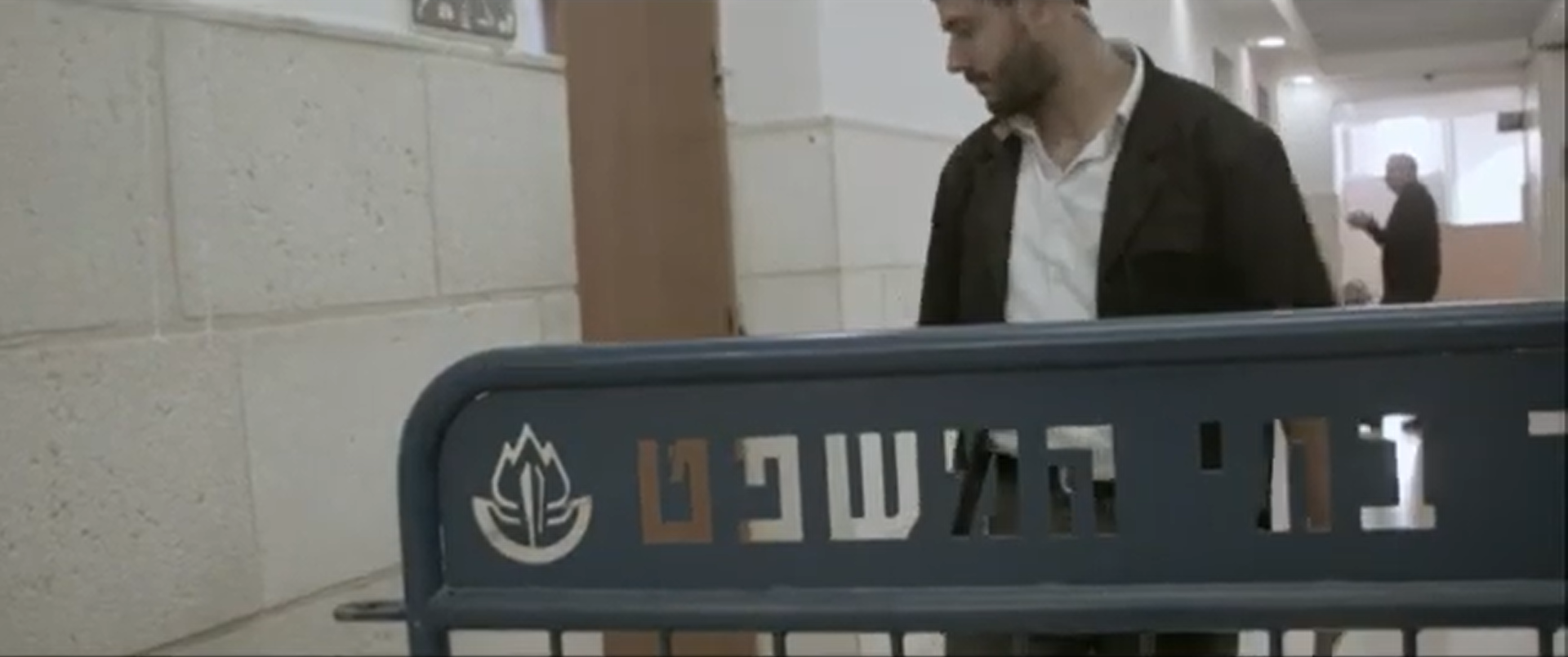
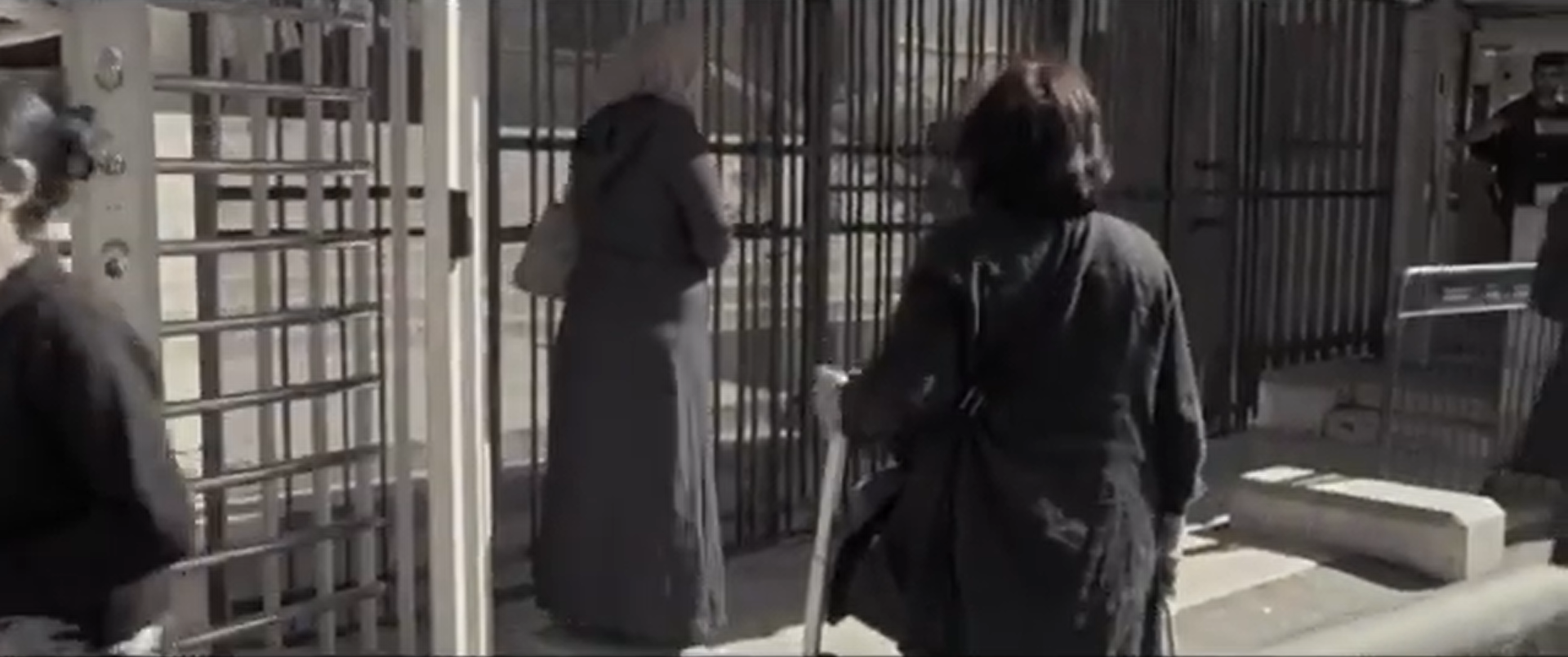
Movement within occupied Palestine is largely restricted by military checkpoints, frequent arbitrary road closures, and separate roads for Israelis and Palestinians; this pervasive instrument of apartheid seeps into the courthouse, where similar structures operate in unrecognizable, often invisible ways as they are transferred and enforced across different systems and bodies. While the court complex’s entrance is predictably sealed by metal gates and turnstiles, the conditions for entry are distinct from those at checkpoints. For example, while Israa’s sister walking alone is denied entry into the court by the guard, Tsemel can ask that she be admitted. If checkpoints throughout the West Bank with registered requirements for entry (work authorizations, IDs, etc.) still prove highly erratic and subjective, the courthouse gates with no codified paperwork are evermore so capricious. While Tsemel forgoes some of her stature by defending Palestinians in court, most notably receiving continual death threats and being called “devil’s advocate” in the media, this scene shows her intrinsic privilege as an Israeli. Tsemel becomes another threshold herself, along with the gate and the guard, as they collectively determine who from the outside is allowed inside.
If the gate and turnstile, along with the tacitly approved Israeli guard and defender, are a buffer at the building’s entrance, then the extra space outside the courtroom also assumes a certain regulatory function. Here, too, buildings and bodies work together to control movement. The frame is now limited to a security guard and a single metal barricade, which the guard repositions by hand. As Lea Tsemel enters the courtroom, the door is held open for her and then shut on her Palestinian staff, who must show ID to prove they belong with Tsemel. What marks this threshold as different from the exterior checkpoints is the speed at which security can stiffen or relax based on the heavily perceived identities of each body crossing it. The inner courtroom is not only insulating the judicial process but also filtering Palestinian access as tightly as possible. The redundancy of exclusion goes even further when we observe that Ahmad’s parents are allowed into the courthouse but denied entry into the courtroom proper. Importantly, the documentary cameras continue to film outside even after the security guard blocks their entry. The parents are filmed leaning against the walls in the hallway, checking voicemails and scrolling on their phones: daily banal acts that constitute another, less spectacular, layer of the occupation.
Ahmad’s parents are restricted not only in movement but also in the information they receive. While looking down at their phones, they suddenly notice their son being rushed out of the courtroom and realize that his case has adjourned. They ask Tsemel the verdict because they have been made outsiders in the hall, unable to know their son’s fate firsthand. Here, Ahmad’s parents are just as much on the outside as anyone physically standing outdoors. We see how subjective these spaces become when restrictions in movement ultimately impede one’s ability to participate in a legal process that affects them directly.
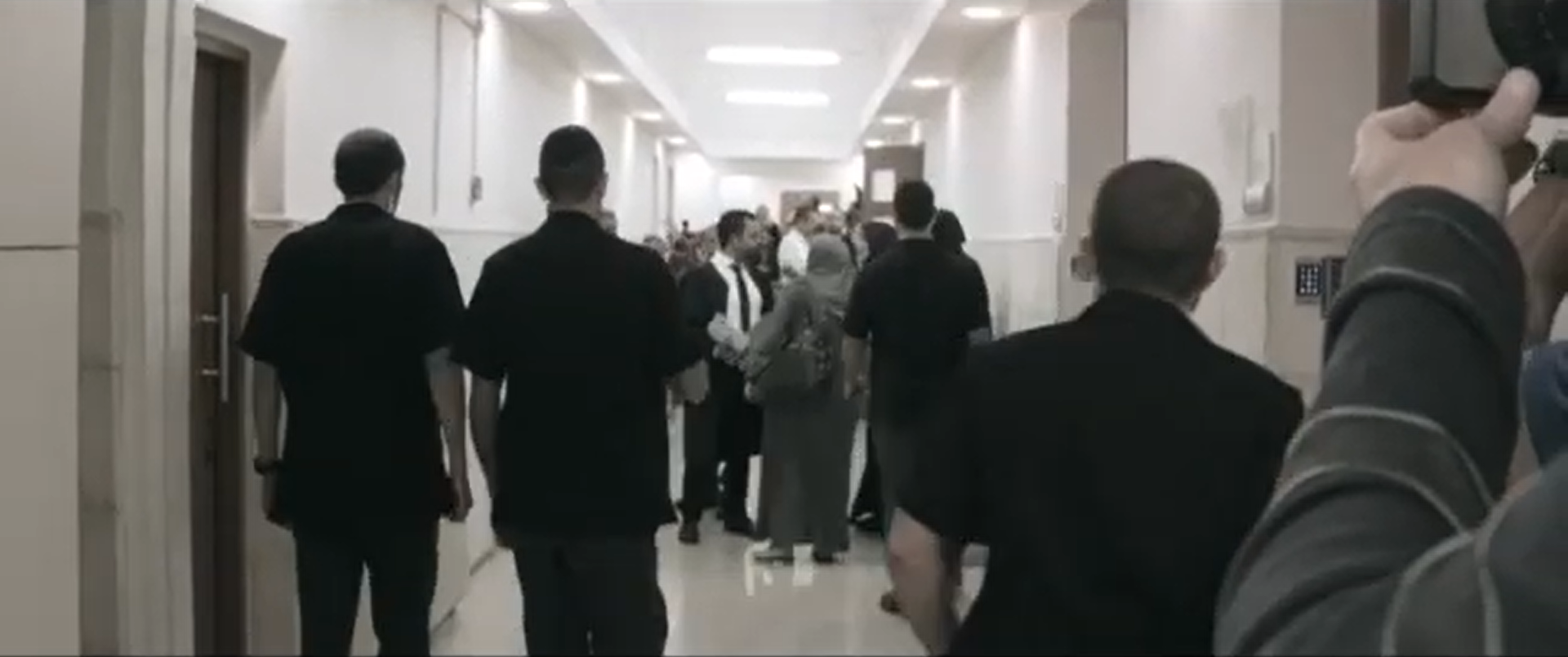
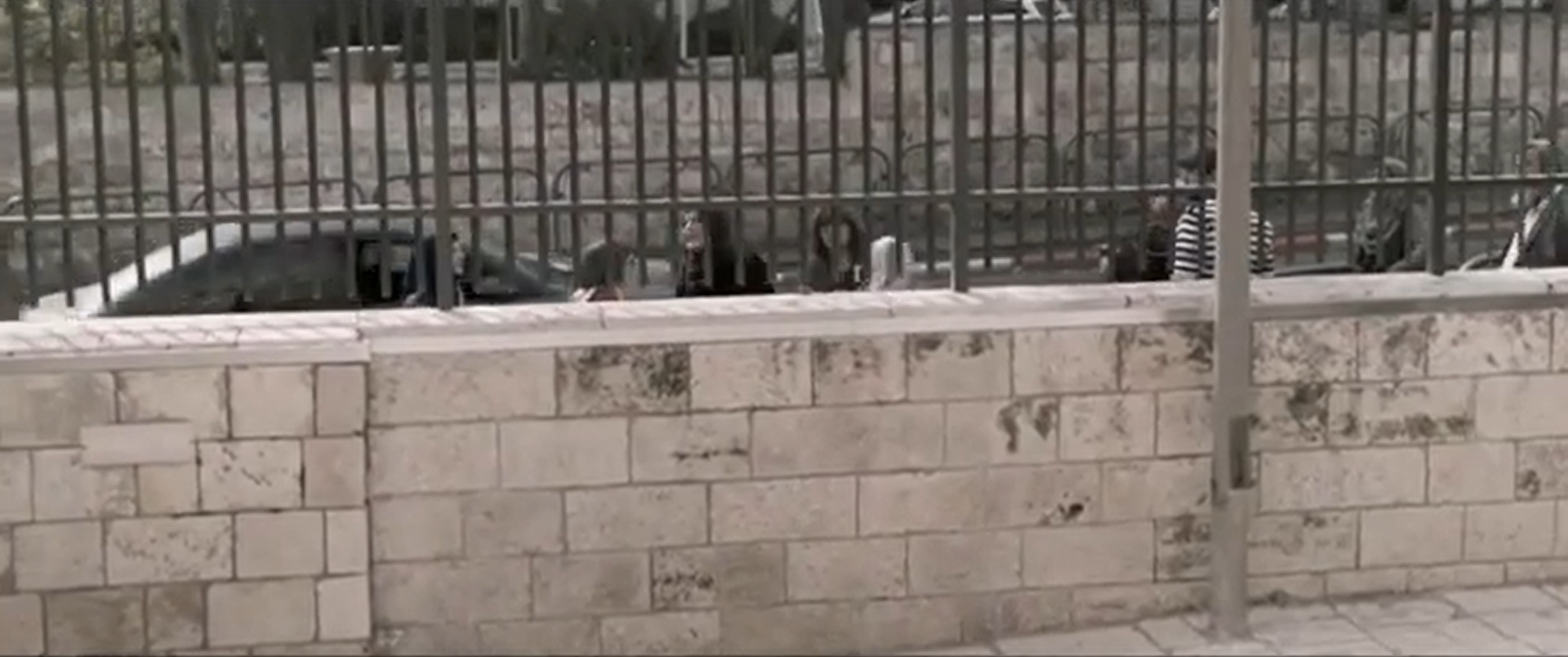
The restriction of information is not limited to Ahmad’s parents. Tsemel and Israa cross paths when the defender walks from the elevator to the courtroom to join her defendant, who is already leaving the courtroom to go back to the elevator. The court’s procedures are slyly rushed to exclude Tsemel herself from critical information. Here in the hallway, Israa’s family receives news of her eleven-year sentence. While the camera does not keep filming past Ahmad’s verdict, it does after Israa’s is delivered. Unaware that sentencing began and ended so quickly, Tsemel immediately tries to get into the courtroom for answers, and Israa’s family follows. Later, as her sister and father cry in the hallway, their grief and anger erupt outside along the sidewalk as the family rails at the state. Israa’s mother weeps uncontrollably, her cries heard as she passes behind a stone wall.
These reactions to proceedings from the courtroom’s interior ultimately construct their own event, that of grief and anger. As the prosecutors leave the courtroom, having just transformed the accused into the incarcerated, the family’s grief and anger are aimed not at the vacuum of space but directly at their occupiers. A rare space unfolds where Israeli authorities must confront the human emotion their decisions cause. In an accident of the architecture’s securitization, the hallway exposes its devastating effects. Are Ahmad’s and Israa’s families, confined to outsider status while inside the courthouse, able only to weep and shout? Or are they able to impact the courthouse proceedings even as the space is designed to marginalize them? Too often in scholarly work on the Israeli-Palestinian conflict and other contemporary colonial struggles, the occupied is given little to no agency in the media that form their narrative. Eminent scholars including Gayatri Spivak and Achille Mbembe have carved foundational paths to think through postcolonial subjectivities, and their calls to consider postcolonial agency have recently been probed further. Laura Junka complicates their arguments through an analysis of Gaza Beach as it sits between life, pleasure, resistance, and agency. In doing so and asking where the postcolonial subject can find pleasure amidst control and protest, she reaffirms the sensitivity of analyzing the occupation:
Israel today is able to employ such a complex constellation of different forms of power and hi-tech superiority that it has secured an absolute domination over the space as well as the lives of the Palestinians, turning their status into that of “living dead” and their daily experience into an institutionalised state of total siege... And yet, perhaps it is exactly in this non-strategic, non-teleological hoping subject that a space for Palestinian agency and its representation beyond the narrow parameters of suicide and victimhood remains open... If expressions of Palestinian resistance in terms of control over death and the aesthetics of martyrdom generate little understanding of the Palestinian cause, other indispensable and more hopeful forms of Palestinian agency and subjectivity have been pushed to the margins of political discourses where no systems of political representation are available to them.14
Are the banal transitory spaces also in a state of total dominion? Ultimately responsible for crafting and reorienting the narrative, Advocate’s filmmakers offer little to no help in addressing Junka’s qualms, neither in their cinematography nor in their screenplay. The viewer loses any semblance of interiority to these real people Tsemel is defending amid the legal whiplash. The last time we see Israa’s family is on the sidewalk outside the courthouse, grieving the verdict with no sense of where they go from there. While the film is foremost dedicated to following Tsemel, when these Palestinian families become involved and highly visible on-screen, it becomes critical for the filmmakers to strategically configure their positionality within both Advocate and the larger media ecosystem in which they are already enmeshed. How can media such as documentary filmmaking reveal these sobering, blunt issues of the criminal justice system in an apartheid state while granting some agency and voice to those who are living within it?
Advocate provides the viewer with rare visuals of the apartheid system in motion, in a space that claims to uphold law and order yet operates under complex and often asynchronous conditions that both mirror and challenge other settler colonial systems we see in the media. A little over a decade ago, the Israeli human rights organization B’tselem launched the Camera Project, one of the first online public databases where Palestinians in the West Bank could record and upload videos documenting daily life under occupation, with video cameras provided by the organization.15 The Camera Project provided the agency that Advocate struggles to facilitate, one that has notably already adapted to film through projects like Mumbai-based CAMP (Ashok Sukumaran and Shaina Anand) studio’s 2013 film From Gulf to Gulf to Gulf. While Instagram and other social media may nowadays contribute to this initiative off-screen, Advocate shows us there are still many architectures of occupation to render visible via documentary film and other methods. Accessing the inner architectures of this apartheid exposes viewers to a less spectacularized, less saturated, yet equally crucial failing of human rights in Palestine. These inner architectures unveil complex layers and motives that reconstruct narratives, regulate bodies, and augment tensions. Yet where can agency be afforded to those who are directly implicated inside this architecture? In his 1984 essay “Permission to Narrate,” Edward Said attested that, while facts on the ground of Palestine may “speak for themselves,” Palestinians still had not gained the permission to narrate.16 While Advocate finds facts that are very much veiled and underrepresented, inching closer to a fuller, more accessible picture of apartheid, Said reminds us that access to the means and permission to narrate these architectures remains an ongoing battle.
-
Noura Erakat, Justice for Some: Law and the Question of Palestine (Stanford, CA: Stanford University Press, 2019). ↩
-
Cornelia Vismann and Geoffrey Winthrop-Young, Files: Law and Media Technology, (Stanford, CA: Stanford University Press, 2008). ↩
-
Eyal Weizman, Hollow Land: Israel’s Architecture of Occupation (New York: Verso, 2007). ↩
-
Thomas Keenan and Eyal Weizman, Mengele’s Skull: The Advent of a Forensic Aesthetics (Berlin: Sternberg Press, 2012), 30, link. ↩
-
Piyel Haldar, “In and Out of Court: On Topographies of Law and the Architecture of Court Buildings,” Revue internationale de semiotique juridique 7, no. 2 (June 1, 1994): 196. ↩
-
Keenan and Weizman, Mengele’s Skull. ↩
-
Gil Hochberg’s recent book, Becoming Palestine: Toward an Archival Imagination of the Future, provides critical complimentary readings of media and archives in Palestine and, more specifically, the ways artists across disciplines are radically imagining Palestine’s future. Gil Hochberg, Becoming Palestine: Toward an Archival Imagination of the Future (Durham, NC: Duke University Press, 2021). ↩
-
The film does not highlight Tsemel’s predecessor, Felicia Langer, a German-Israeli attorney and human rights activist who was the first Israeli to defend Palestinian political prisoners in the West Bank and the Gaza Strip. Langer also authored several books and publications dedicated to exposing the human rights violations in Israel. See Felicia Langer, With My Own Eyes: Israel and the Occupied Territories, 1967–1973, (London: Ithaca Press, 1975); Felicia Langer, These Are My Brothers: Israel & the Occupied Territories, (London: Ithaca Press, 1979); and Felicia Langer and George Moffett, “A Judicial System Where Even Kafka Would Be Lost: An Interview with Felicia Langer,” Journal of Palestine Studies 20, no. 1 (1990): 24–36. ↩
-
Both cases were tried in civilian court, atypical for these kinds of crimes. While the film does not explain why they are tried in civilian court, it is likely due to the media attention each case received at the time. The Jerusalem District Court, one of five district courts in Israel, is situated in between the Magistrate and Supreme Courts, handling criminal cases where the accused faces more than seven years of imprisonment. ↩
-
“Illegal Israeli Settlement Plans Threaten Palestinian Human Rights,” Amnesty International, October 5, 2010, link. ↩
-
Ylenia Gostoli, “Palestinian Teen Could Face ‘Maximum Sentence,’” Al Jazeera, January 17, 2016, link. ↩
-
The explosion of Israa’s car left her with severe burns all over her body, and Israa requests not to be photographed. The guards yell at the media not to photograph, but with little success. Even as a minor, Ahmad is given little protection from the cameras. ↩
-
Advocate, directed by Philippe Bellaïche and Rachel Leah Jones (Home Made Docs, 2019), 1:48 hrs. ↩
-
Laura Junka, “The Politics of Gaza Beach,” Third Text 20, no. 3–4 (May 1, 2006): 4, 21–28. ↩
-
Edward Said, “Permission to Narrate,” Journal of Palestine Studies 13, no. 3 (1984): 47. ↩
Max Goldner is a diasporic Jewish educator, writer, cello teacher, ex-choreographer, and sometimes participates in architectural praxis. He is a recent graduate of GSAPP's MArch and CCCP programs, where his thesis, “Shooting and Crying: Constructions and Translations of (Para-)Jewish Subjecthood,” received outstanding honors.
